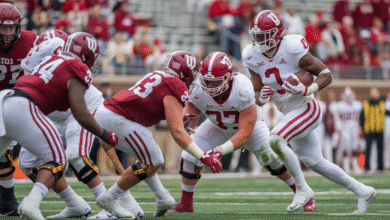Everyone Watches Women’s Sports: The Rising Popularity and Impact

In recent years, women’s sports have seen an unprecedented surge in viewership, engagement, and cultural significance. The phrase “everyone watches women’s sports now” is no longer an exaggeration but a reflection of a shifting landscape where female athletes are finally receiving the recognition they deserve. From record-breaking attendance at women’s soccer matches to skyrocketing TV ratings for the WNBA and women’s tennis, the demand for women’s sports is at an all-time high.
This article explores the factors driving this growth, the challenges that remain, and the future of women’s sports in a rapidly evolving media landscape. We’ll also address frequently asked questions about viewership trends, media coverage, and the economic impact of women’s sports.
Why Is Women’s Sports Gaining More Viewers?

The rise in viewership for women’s sports can be attributed to several key factors. First, there has been a significant push for gender equality in sports, with more media outlets dedicating airtime to women’s leagues. Major networks like ESPN, BBC, and Sky Sports have increased coverage, ensuring that fans have greater access to games and tournaments.
Another driving force is the star power of female athletes. Players like Serena Williams, Megan Rapinoe, and Caitlin Clark have become household names, drawing in casual fans and inspiring younger generations. Social media has amplified their reach, allowing athletes to connect directly with audiences and build personal brands outside traditional media.
Additionally, corporate sponsorships and investments have played a crucial role. Companies are recognizing the commercial potential of women’s sports, leading to better-funded leagues, higher production quality, and more marketing campaigns. The 2023 Women’s World Cup, for example, broke records with over 1.5 billion viewers, proving that women’s sports can compete with men’s in terms of global appeal.
The Role of Media in Promoting Women’s Sports

Media coverage has historically been one of the biggest hurdles for women’s sports. Studies have shown that only about 4% of sports media coverage is dedicated to women’s events, but this is slowly changing. Streaming platforms like DAZN and YouTube have made it easier for fans to watch games on demand, while social media highlights help viral moments reach millions.
Traditional broadcasters are also stepping up. The WNBA’s recent media deals have ensured more games are televised, while women’s football leagues across Europe are securing better TV slots. The increased visibility not only boosts ratings but also normalizes women’s sports as a mainstream entertainment product rather than a niche interest.
However, there is still progress to be made. Commentators often focus on female athletes’ appearances rather than their skills, and pay disparities remain a contentious issue. But with growing public pressure, media companies are being forced to address these biases and provide more equitable coverage.
Economic Growth and Investment in Women’s Sports

The financial landscape of women’s sports is transforming rapidly. Sponsorships, merchandise sales, and ticket revenues are all on the rise. The WNBA, for instance, reported a 60% increase in merchandise sales in 2023, while the National Women’s Soccer League (NWSL) has seen franchise values skyrocket from 5milliontoover50 million in just a few years.
Investors are taking notice. Private equity firms and sports conglomerates are pouring money into women’s leagues, recognizing their untapped potential. Even traditionally male-dominated sports like boxing and MMA are seeing a surge in female participation and fan interest, with fighters like Claressa Shields and Amanda Nunes headlining major events.
Still, pay gaps persist. While top female athletes now earn millions through endorsements, the average salary in women’s leagues remains far below that of men’s. Closing this gap will require continued advocacy, better revenue-sharing models, and sustained fan engagement.
The Cultural Impact of Women’s Sports

Beyond economics and media, women’s sports are reshaping cultural perceptions. Young girls now have more role models than ever, and the narrative around women in sports is shifting from novelty to norm. Movements like #SeeHer and Women’s Sports Foundation campaigns have pushed for greater representation in coaching, leadership, and broadcasting roles.
Moreover, women’s sports are challenging stereotypes about athleticism and competitiveness. Matches like the 2023 NCAA Women’s Basketball Championship, which drew higher ratings than the men’s final, prove that the quality of play is just as compelling—if not more so—than men’s sports in some cases.
This cultural shift is also evident in fan behavior. Stadiums are filling up, social media engagement is breaking records, and conversations around women’s sports are becoming more mainstream. The days of dismissing women’s leagues as “less entertaining” are fading fast.
Challenges and Barriers Still Facing Women’s Sports
Despite the progress, significant challenges remain. Unequal pay, limited media coverage in certain regions, and institutional biases continue to hinder growth. Many women’s leagues still struggle with inadequate facilities, travel conditions, and investment compared to their male counterparts.
Another issue is the lack of long-term media contracts. While some leagues have secured better deals, others rely on short-term agreements that don’t provide financial stability. Additionally, female athletes often face disproportionate scrutiny over their appearance, personal lives, and even their athleticism, which can overshadow their achievements.
Addressing these barriers will require systemic changes—more corporate sponsorships, better league structures, and continued advocacy from fans and athletes alike. The momentum is there, but sustained effort is needed to ensure women’s sports don’t plateau.
The Future of Women’s Sports: What’s Next?
The future of women’s sports looks brighter than ever. With increasing digital consumption, the rise of women’s esports, and more young athletes entering the scene, the growth trajectory is set to continue. Leagues are expanding, new tournaments are being created, and global interest is reaching unprecedented levels.
Key trends to watch include:
- Expansion of women’s leagues (e.g., NWSL adding new teams, European women’s football leagues growing).
- More streaming partnerships (platforms like Netflix and Amazon Prime exploring live sports rights).
- Grassroots development (greater investment in youth programs to nurture future stars).
- Technological advancements (VR experiences, enhanced broadcasts, and interactive fan engagement).
If current trends hold, women’s sports could soon rival men’s in terms of popularity and profitability. The phrase “everyone watches women’s sports” may soon be an undeniable reality.
Conclusion
The rise of women’s sports is one of the most exciting developments in modern athletics. From record-breaking viewership to groundbreaking investments, female athletes are finally getting the platform they deserve. While challenges remain, the progress made in media coverage, financial backing, and cultural acceptance suggests a future where women’s sports are no longer an afterthought but a dominant force in global entertainment.
As fans, sponsors, and media continue to rally behind women’s leagues, the message is clear: everyone is watching women’s sports now—and they’re here to stay.
Frequently Asked Questions (FAQs)
1. Why has women’s sports become more popular recently?
The increase in popularity is due to better media coverage, the rise of star athletes, social media engagement, and greater investment from sponsors and leagues.
2. How does media coverage of women’s sports compare to men’s?
While still lagging behind men’s sports, coverage has improved significantly, with more live broadcasts, streaming options, and highlight reels on social media.
3. Are female athletes paid equally to male athletes?
No, pay gaps still exist in most sports, but top female athletes are now earning more through endorsements and league growth.
4. Which women’s sports have the highest viewership?
Soccer (FIFA Women’s World Cup), basketball (WNBA), tennis (Grand Slams), and gymnastics (Olympics) currently lead in viewership.
5. What can fans do to support women’s sports?
Fans can watch games, buy merchandise, engage on social media, and advocate for equal media coverage and pay.
6. Will women’s sports ever be as popular as men’s?
With current growth rates, it’s possible—especially in certain sports where women’s competitions already rival men’s in engagement.
7. How can young girls get involved in sports?
Parents and schools should encourage participation, provide access to local leagues, and expose them to female athlete role models.




